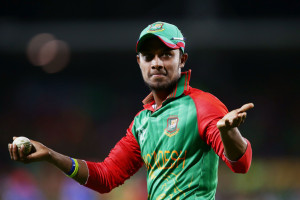Leg spinners have played important role in recent World T20
Rashid Khan, Shahid Afridi, Jeffrey Vandersay and Adil Rehman
By Gaurav Joshi
Picking leg spinners in T20 cricket was always considered a risky business. However, in the current World T20 leg spinners seem to have been an integral part of each playing XI. Since the start of the Super 10 stage, nine of the ten countries have used a leg spinner.
Ish Sodhi of New Zealand, Sabbir Rehman (Bangladesh), Adam Zampa (Australia), Shahid Afridi (Pakistan), Adil Rashid (England), Imran Tahir (South Africa), Rashid Khan (Afghanistan), Jeffrey Vandersay (Sri Lanka) and Samuel Badree (West Indies) have between them sent down 116 overs, taken 42 wickets at an average of 17.11 and at an economy rate of 6.27. It has been a decorated tournament for leg spin bowling.
Adam Zampa and Sabbir Rehman
Each of them is different. There are the ageing warriors in Afridi and Tahir, both in their late 30s but still extremely effective. Afridi’s straight bustling run up contrasts to Tahir’s angled approach. Both rely on beating the batsmen for pace off the pitch and ensuring each ball’s projected path is towards the stumps.
Samuel Badree and Imran Tahir
On the other end of the scale is Rashid Khan. The 17 year old is touted as ”˜leg spinner’ but rarely spins the ball away from right-handed batsmen, preferring to bowl a googly nearly every ball. With a high and a slightly awkward bowling action, in which he releases the ball almost off the wrong foot, Rashid Khan’s freshness has added to another dimension to the Afghanistan story.
Then there is Badree, the power play specialist. Out of the crop, he must be the one with most self belief knowing a small error can lead to maximum impact. He has learned to be deadly accurate with quick arm action so the batsmen have no time to come down the pitch. Of all the leg spinners, he is probably the one with the least variation but his ability to land the ball on a dime ”“ ball after ball ”“ is an art that needs to be commended.
The most classical of the lot is Sodhi. With slightly side-on run up, the arm slanted at the point of delivery, he is perhaps the only bowler with a big turning leg break. His ability to spin the ball sharply and dip it in has made him the most difficult bowler to confront. Besides he is the most well built of the lot, standing at 6’2” with broad shoulders. He has shown in this tournament that since learning to bowl a big spinning leg break, his cleverly disguised googly has become more of a weapon. Pace through the air has also been phenomenal. Bowling at speed around mid-80 kmh has enabled him to spin the ball off the surface.
England’s Adil Rashid, is the slowest of the lot. Of all these spinners he relies on flight. His vertical arm at delivery also means he gets plenty of top spin. Unfortunately for him, he has had to fight against dew and his style of bowling is perhaps more suited to pitches which have bounce. His trajectory is completely different to that of Afridi, Badree or Tahir. Rashid is a flight master but just needs a bit of pace.
Adam Zampa is also a classical limited-overs leg spinner. Like most of his leg spinning colleagues, the arm is very high at delivery, so has plenty of overspin but lacks the side spin. In the mould of Tahir he is a real threat when the batsmen are trying to attack him. Zampa has enough subtle variety of pace and has a googly. He could have been more effective in the tournament had the captain backed him more.
The two most unnoticed leg spinners are Sabbir Rehman and Jeffrey Vandersay. More of a part-time leg spinner Rehman is still in a similar mould to Vandersay because both of them barely use their bodies at the crease. Both of them rely largely on their arm, shoulder and upper body meaning the revolutions on the ball are well down compared to other spinners’. Their follow through is nonexistent but they have shown on a slow low surface that this style of leg spin can still be effective.
In the past we have seen fast bowlers with all the variety. Now it is the leg spinners. As mentioned, each of the nine leggies have different run ups, trajectories, body rotation, arm angle at delivery, revolutions on the ball, dedicated roles and also the faith of the captain.
Different styles of leg spinners have embraced the World T20 and as statistics show they have been a great success.
Short URL: https://indiandownunder.com.au/?p=6621









